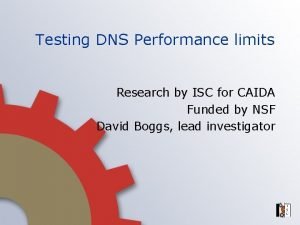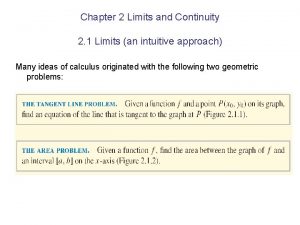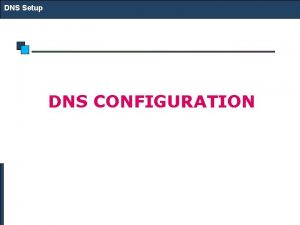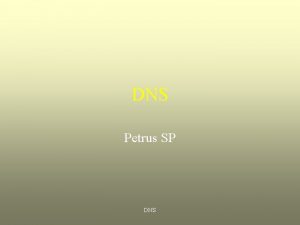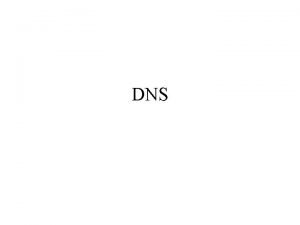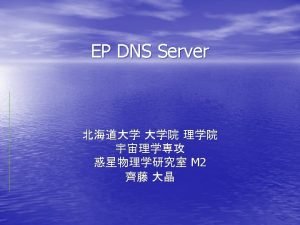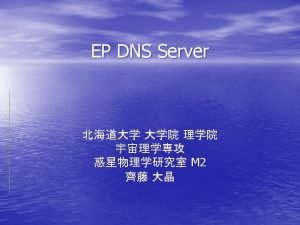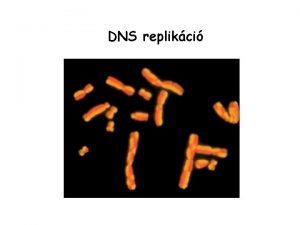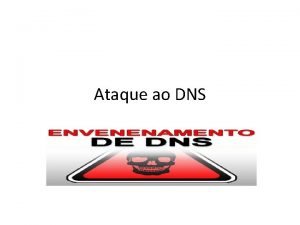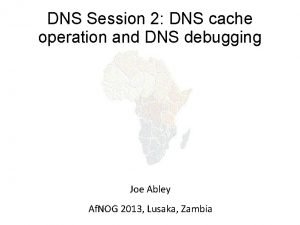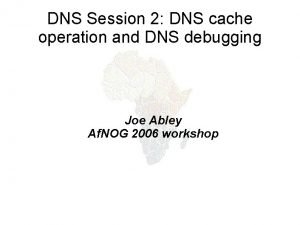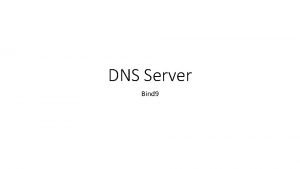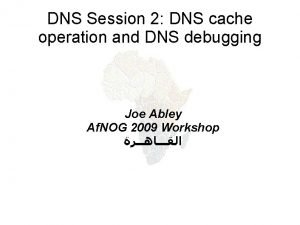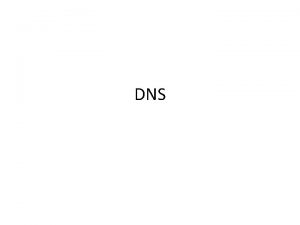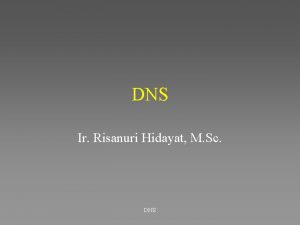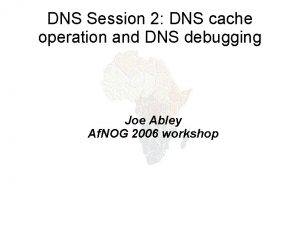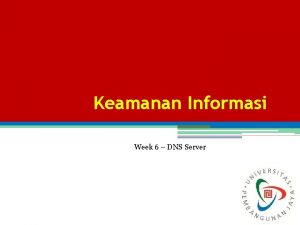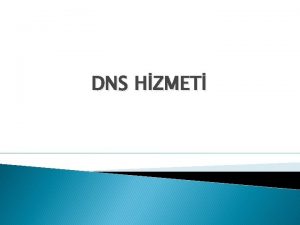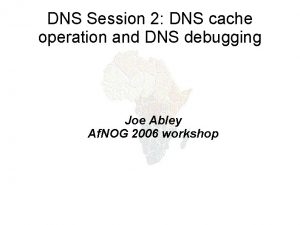Testing DNS Performance limits the Final Chapter Research
























- Slides: 24

Testing DNS Performance limits the Final Chapter Research by ISC for CAIDA Funded by NSF David Boggs, lead investigator Brian Reid, writer and reporter

DNSPERF Project overview • Build testbed big enough to test. COM, . NET TLD service • Test its maximum capacity (query rate at server overload point) • Reconfigure to use DDNS for updates, IXFR for distribution • Test under load, find maximum

Physical testbed • 13 affordable COTS servers • 1 Stealth master for IXFR sourcing • Non-blocking GB ethernet • Load generator • Update generator • Monitoring

Logical diagram

Physical diagram

What hardware? • Affordable under limited budget ($100 K available to buy 16 servers) • Candidates: Sun X 4200, HP DL 140 G 3, Iron Systems I-class, Mclass (Intel Xeon and AMD 28 x) • Must run open-source OS • Choose by memory performance

Hardware test results

Hardware decision • HP DL 140/G 3 • Surprised that Intel processors outperformed AMD for these tests • Able to afford 16 GB RAM in each (8 pairs of matched 1 GB parts)

What software? • BIND 9. 4 • OS: Test these, pick the fastest Linux (Gentoo, Fedora), Free. BSD (6, 7), Solaris 10, Net. BSD 4, Open. BSD 4. 1, Windows 2003 Server, Windows XP Pro 64

What test? • Loaded server with. PT zone • Used queries from 48 -hour F-Root capture, sent with queryperf • Ramped query rate until server limit reached • Ran test at server limit for 1 hour (1. 13 millioin queries)

OS Performance queries/sec

Test data stream • 48 -hour capture from F-Root • 414931073 requests (38. 8% failed) • Avg rate (req/sec) = 2401. 2 95%ile burst = 3011. 0 Max burst = 3921. 9

Test data stream

Testing with. COM • Used COM zone from 5 Oct 2007 Split into 2 parts Each part about 87, 000 entries One server for each part • Raw zone slice file sizes 3 GB each

New numbers • We presented some numbers in November 2007. • Today’s numbers are different. • Two sources of differences: COM zone split into slices to fit memory BIND stderr now piped to /dev/null (profiling showed lots of time wasted in console error messages)

Testing with COM in 2 slices

Measuring update performance • After measuring server performance on fixed zone, we measure rate at which we can update that zone. • Updates use RFC 2136 protocols and standard BIND tools • Update stream was synthetic

DDNS updates to COM • We sent 10, 000 DDNS updates to BIND 9. 1. 1 -P 1 at maximum speed. • Zone being updated was 50% slice of COM, one server per slice. • Table shows rate at which updates can be committed to stable storage. • We believe the Free. BSD 6. 2 anomaly to be a compiler or config bug that omitted fsync calls.

COM update rate limits

Final test: query during update • Measured performance of COM zone during DDNS update and IXFR. • Made slight modification to BIND 9. 4. 2 for this test (disabled periodic write to stable storage, since this is not master copy of zone) • Measured for signed and unsigned zones.

�Notes on the test and results • Recall that DDNS updates to COM zone max out around 90/sec • So the test sequence 1, 2, 4, 8, 16, 32, 64, 128 updates/sec is really 1, 2, 4, 8, 16, 32, 64, 90 • This test performed only with Free. BSD 7. 0 -RELEASE

Query reply rate of server under update via IXFR *DDNS updates of master maxed at 90/second

Conclusions • Open source software and commodity hardware up to the task of serving large real zones • Real-world COM update rates average only 24/second, peaked at 10/second during 2006 and 2007. • Signed zone service is only 10 -15% slower than unsigned • Slicing a zone for multiple servers works fine. • Constant zone update does not significantly degrade server’s query-response performance.

For more information • ISC Tech Note TN-2008 -1 ftp: //ftp. isc. org/isc/dns_perf/ISC-TN-2008 -1. pdf • Contact info@isc. org to inquire about research access to this testbed (it is available to other researchers)
 Dns performance testing
Dns performance testing Limits involving infinity asymptotes
Limits involving infinity asymptotes Real limits vs. apparent limits
Real limits vs. apparent limits Domain testing in software testing
Domain testing in software testing Motivational overview of logic based testing
Motivational overview of logic based testing Du path testing
Du path testing Positive and negative testing
Positive and negative testing Cs3250
Cs3250 What is globalization testing
What is globalization testing Functional testing vs unit testing
Functional testing vs unit testing Cause effect graphing technique
Cause effect graphing technique Control structure testing in software engineering
Control structure testing in software engineering Decision table testing in software testing
Decision table testing in software testing Decision table advantages and disadvantages
Decision table advantages and disadvantages Jelaskan pengertian pengujian black box
Jelaskan pengertian pengujian black box Behavior testing adalah
Behavior testing adalah Decision table for triangle problem
Decision table for triangle problem Rigorous testing in software testing
Rigorous testing in software testing Testing blindness in software testing
Testing blindness in software testing Component testing is a black box testing
Component testing is a black box testing Software domain examples
Software domain examples Chapter 2 limits and continuity
Chapter 2 limits and continuity China limits european contacts
China limits european contacts Limits and their properties
Limits and their properties Parliament limits the english monarchy
Parliament limits the english monarchy
